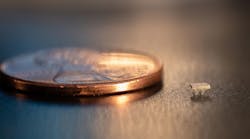Researchers at the Georgia Institute of Technology have developed a robot that is 3D printed and powered by vibrations in the surrounding environment. It measures approximately two millimeters in length, 1.8 millimeters wide and 0.8 millimeters thick, and weigh about five milligrams. The prototype robots respond to different vibration frequencies depending on their configurations, letting researchers control individual bots by using different frequency vibrations. When moving, the microbots can cover four millimeters per second.
The micro-bristle-bots consist of a piezoelectric actuator glued onto a polymer body that is 3D-printed using two-photon polymerization lithography. The actuator generates vibration and is powered externally because no batteries are small enough to fit on the bot. The vibrations can also come from a piezoelectric shaker beneath the surface on which the robots move, from an ultrasound/sonar source, or even from a tiny acoustic speaker.
The vibrations move the springy legs up and down, propelling the micro-bot forward. The micro-bot’s legs are designed with specific angles that let them bend and move in one direction in resonant response to the vibration. Each robot can be designed to respond to different vibration frequencies depending on leg size, diameter, design, and overall geometry. The vibrations’ amplitudes control the micro-bot’s speed.
The micro-bristle-bots are made in a 3D printer using the TPP process, a technique that polymerizes a monomer resin. Once the portion of the resin block struck by the UV light to cure, excess polymer powder can be washed away and reused, leaving the desired robotic structure. The process takes quite a while, but the team is looking at ways to scale it up to make hundreds or thousands of micro-bots at a time.
The piezoelectric actuators, which are made of lead zirconate titanate (PZT), vibrate when electric voltage is applied to them. In reverse, they can also be used to generate a voltage when they are vibrated, a capability the micro-bristle-bots could use to power up onboard sensors when actuated by external vibrations.
The team is also are working to add steering to the robots by joining two slightly different micro-bristle-bots together. Because each of the joined micro-bots would respond to different vibration frequencies, the combination could be steered by varying frequencies and amplitudes.
Other researchers have worked on micro-robots that use magnetic fields to produce movement. Although that is useful for moving entire swarms at once, magnetic forces cannot easily be used to address individual robots within a swarm. The 3D printer can produce smaller robots, but with a reduced mass, the adhesion forces between the tiny devices and a surface can get very large. Sometimes, the micro-bots cannot be separated from the tweezers used to pick them up.
Ansari and her team have built a “playground” in which multiple micro-bots can move around as the researchers learn more about what they can do. They are also interested in developing micro-bots that can jump and swim. Swarms of these “micro-bristle-bots” might work together to sense environmental changes, move materials, or repair injuries in patients.

